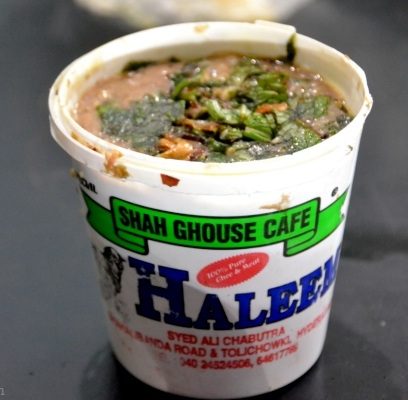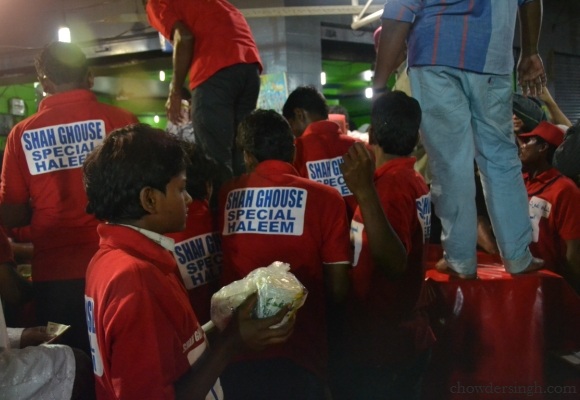
Haleem or Halim is an Arabic / Persian adjective that takes on the connotations of calm…. patient…. not in haste. The word takes on a completely new meaning during Ramzaan in Hyderabad – Frenzy. My first experience with the Hyderabadi Haleem many years ago was at Shah Ghouse hotel in Shah Ali Banda, Old City Hyderabad. There was a big crowd and everyone seemed to be waiting in anticipation. Then two guys came with a big sized milk can and turned over the Haleem in a big deg (deep vessel for slow cooking).
The Haleem was obviously being prepared in bulk elsewhere and brought here to be dished out. As soon as the haleem’s transferred from the milk can to the deg, the frenzy began. Everyone started pushing each other to get to the haleem counter. I was under the impression that this was some free counter for the underprivileged. Muslim culture is big on charity and I was imagining this to be the Hyderabadi alternative to the Garib Nawaz restaurant concept that one sees elsewhere. I asked the person standing next to me on how to buy the haleem at Shah Ghouse and he pointed in the direction of the cash counter where a token had to be taken.

I bought a token and asked the person at the counter from where to get the haleem from. He pointed in the direction where all the frenzy was happening. I realised that all that pushing and shoving was by everyone who bought tokens. There was no free counter. So after waiting for a long time and seeing the milk cans come one by one. I pushed my way through and at the same time got a good body massage by the sea of people around. It’s one of the few instances I’ve been in. Where you want to step ahead, but your body is going to the right and your head is being pushed to the left.
Harees was brought to Hyderabad most likely by the Hadhrami arabs, who were soldiers with the earlier Qutb Shahi kingdom and later the Asif Jahis. They were a very important part of the Nizam’s army and had their barracks located in Barkas on the outskirts of Hyderabad. They brought with them typical Hadhrami Arab dishes like Mandi, Majboos, Kabsa, Harees and drinks like Qahwa (arabic style coffee with saffron and cardamom). Mandi is probably the only dish from the Barkas arab cuisine to become part of mainstream Hyderabad cuisine and culture. Rest of the dishes are still mostly found inside Chaush (Hardhrami Arab palace guards) homes or weddings. Harees is mostly served as a breakfast dish and is made from meat cooked with pounded wheat and spices.
Haleem is a Persian breakfast dish, similar to Harees. Also made with meat, pounded wheat and spices. Haleem was most likely brought to Hyderabad by the Iranis who opened Irani cafes in the city. These Iranis where the cousins of the Iranis of Bombay and Western India. There were two types of Iranis who migrated to India to escape persecution from the Qajar dynasty of Iran – The Zoroastrians and other Muslim minorities of Iran. Irani Cafes in Bombay and Western India are both Zoroastrian Irani and Muslim Irani owned. But it is quite possible that the haleem was present in Hyderabad much before the Iranis came to the city.
Iranian nobility have always been part of the Mughal court and those of Nawabs and Nizams of various provinces across India. The official language of the Mughal court was Farsi. Hyderabad and Iran have always has close ties. The Asaf Jam Nizams were great patrons of Iranian culture and language. It is quite possible that haleem was part and parcel of Hyderabadi culture much before establishment of the Irani cafe culture in the city. But there is no mistaking the fact that it was the Irani cafes in the 1950’s and 60’s, who made haleem Hyderabad’s most popular dish during Ramzaan. And one Irani cafe in particular, stood out in this respect – Madina hotel.
Haleem is a versatile dish and is good as breakfast, a snack or dinner. It’s now a protected dish and has a Geographical Indication tag. The Hyderabadi haleem is made from equal parts of meat, wheat and ghee. Alongwith onion, ginger, garlic, spices, lentils, basmati rice, milk, dried rose petal and nuts. According to the GI specifications, it is supposed to be made only in copper vessels on a bhatti (wood fire furnace). The meat is cooked with spices first for at least 5 hours. Then the wheat, rice, lentil and spices are added. The mixture is slow cooked for another 6 hours. In the last hour of finishing, the mixture is mashed using wooden mallets called ‘ghota’. The meat is mashed into strands called reshe (threads or fibre) in local language. Lastly ghee is poured and mixed in.
A separate flavoured oil or teera is made using onion, turmeric, red chilly, coriander seed powder and ghee. This is poured on top of the haleem at the time of serving along with chopped nuts. In the old days, the wheat was soaked for a couple of days, sun-dried and then dehusked, before adding to the haleem.
It’s tough to find good haleem in Hyderabadi other than in the month of Ramzaan. But come Ramzaan and every street corner is lit up with the prospect of having haleem. The dish that requires the patience of 12 hours of preparation, gets everyone into a frenzy mode.
Click here for my other posts on Hyderabad.
Happy hunting and chowder-on!
Categories:
Tags:

The Irani Cafe Chair – Defining What Is An Irani Cafe

Mumbai’s Infamous Eggless Omelette

The 20 Types of Indian Vegetarians